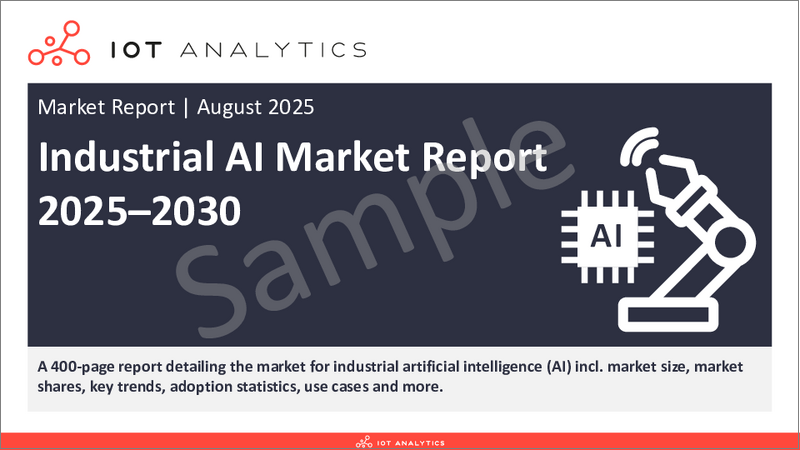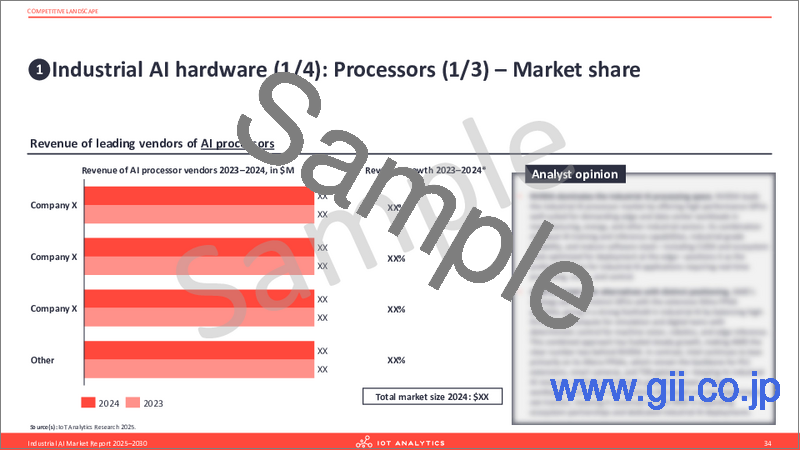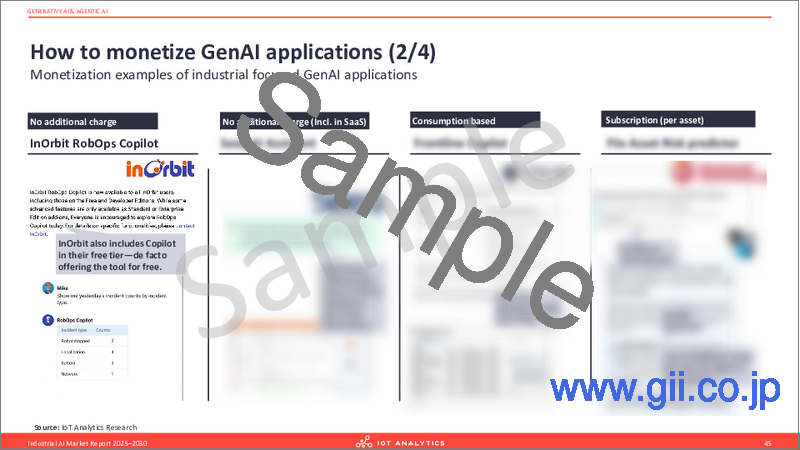|
|
市場調査レポート
商品コード
1775080
産業用AI市場:2025-2030年Industrial AI Market Report 2025-2030 |
||||||
|
|||||||
| 産業用AI市場:2025-2030年 |
|
出版日: 2025年07月23日
発行: IoT Analytics GmbH
ページ情報: 英文 400 Pages
納期: 即日から翌営業日
|
全表示
- 概要
- 目次
当レポートは、IoT Analyticsが継続的に調査しているスマート製造およびAIに関する継続的な調査の一環として提供される400ページにわたるレポートであり、産業用AI市場の現状に関する詳細な市場規模、予測、ベンダーの市場シェア、主要トレンド、使用事例、導入状況統計などを包括的に取り扱っています。
当レポートは、複数の調査、二次情報のリサーチ、専門家やエンドユーザーへのインタビューといった定性的調査に基づいて情報が構成されています。産業用AIおよび関連分野 (エッジAI、ロボティクスにおけるAI、生成AIなど) に関する定義、市場予測、導入促進要因、競合環境、主要な動向と開発事例、ケーススタディが含まれています。
本レポートは、産業用AIおよび関連分野 (予知保全、マシンビジョン&ロボティクス、デジタルツイン、エッジAIなど) に関するIoT Analyticsによる専用調査シリーズの第3弾となります。
プレビュー



プレビュー



レポートハイライト:
- 市場規模・予測:技術スタック (ハードウェア、ソフトウェア、サービス) 、AIタイプ、産業、地域、上位5カ国で区分した詳細な市場モデルと2030年までの予測
- 競合情勢:最大手ベンダー15社の市場シェアと今後参入予定の30社以上を詳細に分析
- 使用事例・採用分析:10のカテゴリーにまたがる48の主要使用事例を深く掘り下げ、採用の促進要因と障壁に関するエンドユーザーの視点を充実化
- 戦略的洞察:産業用AI分野を形成する21の主要市場動向と6つの課題をレビュー
- 技術の深掘り:生成AIとエージェント型AI、エッジAI、ロボティクスにおけるAIを詳細に分析
- 詳細研究:6つの詳細な使用事例と、主要メーカーのAI戦略に関する4つの深堀り
当レポートには、EXCELによる完全な市場モデルデータ、EXCELによる670の産業用AIベンダーのリスト、産業用AIプロジェクトのリスト (チームユーザーおよびエンタープライズプレミアムライセンスのみ) が付属しています。
掲載企業:
本レポートで言及された670社から抜粋
|
|
|
目次
第1章 エグゼクティブサマリー
第2章 イントロダクション
- 分析の種類とAIの役割:概要
- 本レポートの焦点:産業用AI
- AIを理解する:非産業向けAIソリューションと産業向けAIソリューション
- 一般および産業用AIのタイムライン
- 産業用AIへの関心の高まり:産業用AIに関する世界の検索
- 産業用AIへの関心の高まり:ベンダーのコメント
- 産業用AIの関心の文脈:ユーザーの発言
- 産業用AIの関心の文脈:製造業におけるAIの役割
- 一例として、大手自動車部品サプライヤーにおける産業用AIが挙げられます
第3章 技術概要
- 章の概要:技術の概要
- 産業用AI導入プロセス- プロセス概要
- 産業用AI導入プロセス- トピックの概要
- 詳細分析1:AIビジネス価値を決定するための共通フレームワーク
- 詳細分析2:AIシステム要件
- 詳細分析3:AIチップ
- 詳細分析4:AIソリューションの構築と購入
- 詳細分析5:データ管理
- 詳細分析6:データの取り込みと準備
- 詳細分析7:モデルの開発とトレーニング
- 詳細分析8:MLオペレーション
第4章 市場規模と展望
- 章の概要:市場規模と展望
- 2025年の産業用AI市場の一般的な促進要因と阻害要因
- 産業用AI市場:含まれるものと含まれないも
- 世界の産業用AI市場:全体
- データの視点:米国の製造業者がAIに費やす平均的な金額
- 世界の産業用AI市場:技術スタック別
- 世界の産業用AI市場:AIタイプ別
- 世界の産業用AI市場:ホスティングタイプ別のトレーニング
- 世界の産業用AI市場:ホスティングタイプ別の推論
- 世界の産業用AI市場:使用事例
- 世界の産業用AI市場:産業別
- ディスクリート製造業向けAI市場:ISICコード別
- ハイブリッド製造業向けAI市場:ISICコード別
- プロセス製造業向けAI市場:ISICコード別
- 世界の拡張産業用AI市場:地域別
- 東アジア・太平洋地域の産業用AI市場:国別
- 欧州・中央アジアの産業用AI市場:国別
- 北米の産業用AI市場:国別
- 中東・北アフリカの産業用AI市場:国別
- ラテンアメリカおよびカリブ海地域の産業用AI市場:国別
- 南アジアの産業用AI市場:国別
- 世界の産業用AI市場:上位10カ国・産業別 (2024年)
- 中国の産業用AI市場:全体
- 中国の産業用AI市場:技術スタック別
- 中国の産業用AI市場:産業別
- 中国の産業用AI市場:使用事例
- 米国の産業用AI市場:全体
- 米国の産業用AI市場:技術スタック別
- 米国の産業用AI市場:産業別
- 米国の産業用AI市場:使用事例
- ドイツの産業用AI市場:全体
- ドイツの産業用AI市場:技術スタック別
- ドイツの産業用AI市場:産業別
- ドイツの産業用AI市場:使用事例
- 日本の産業用AI市場:全体
- 日本の産業用AI市場:技術スタック別
- 日本の産業用AI市場:産業別
- 日本の産業用AI市場:使用事例
- 韓国の産業用AI市場:全体
- 韓国の産業用AI市場:技術スタック別
- 韓国の産業用AI市場:産業別
- 韓国の産業用AI市場:使用事例
第5章 競合情勢
- 章の概要:競合情勢
- 企業情勢:ベンダー分類
- 調査手法:
- 例:このレポートではNVIDIAの2024年の収益がどのように説明されているか
- 企業情勢:企業データベース
- 産業用AIベンダー最大手15社:概要
- 2024年の競合情勢:技術スタック別の市場シェア概要
- 産業用AIハードウェア:プロセッサの市場シェア
- 産業用AIソフトウェア:競合情勢をどう考えるか
- 産業用AIサービス:市場シェア
第6章 使用事例
- 章の概要:使用事例
- 主な産業用AIの使用事例:2024年の産業用AI市場のシェア
- 主な産業用AI使用事例:定義
- 使用事例1:自動光学検査
- 使用事例1:自動光学検査- ケーススタディ
- 使用事例2:単一資産の予測メンテナンス
- 使用事例2:単一資産の予測メンテナンス- ケーススタディ
- 使用事例3:自律マシン/ロボット
- 使用事例3:自律マシン/ロボット- ケーススタディ
- 使用事例4:サイバーセキュリティの脅威検出
- 使用事例5:システム/プラント全体の予知保全
- 使用事例6:監視と物理的脅威の検出
- 使用事例6:監視と物理的脅威の検出- ケーススタディ
- 使用事例7:自動非光学的障害検出
- 使用事例8:生産の最適化
- 使用事例9:ルートの最適化とスケジューリング
- 使用事例9:ルートの最適化とスケジューリング- ケーススタディ
- 使用事例10:自律物流システム
- 使用事例10:自律物流システム (ALS) - ケーススタディ
- その他の注目すべきケーススタディ
- その他の注目すべきケーススタディ:生成AI
第7章 生成AIとエージェントAI
- 章の概要:生成AIとエージェントAI
- 530件の生成AIプロジェクトの分析:概要
- 530件の生成AIプロジェクトの分析:部門別
- 530件の生成AIプロジェクトの分析:部門別および活動別
- 530件の生成AIプロジェクトの分析:産業別
- 530件の生成AIプロジェクトの分析:産業別・部門別
- 530の生成AIプロジェクトの分析:キャズムを超える
- 生成AIアプリケーションを収益化する方法
- 産業用エージェントAI:概要
- 産業用エージェントAI:モデルコンテキストプロトコル (MCP) - 概要
- 産業用エージェントAI:モデルコンテキストプロトコル (MCP) - 導入
- 産業用エージェントAI:MCP-例
- 産業用エージェントAI:将来のビジョン-1.クリティカル製造
- 産業用エージェントAI:将来のビジョン-2.Siemens
- 産業用エージェントAI:将来のビジョン-3. Mendix
- 産業用エージェントAI:エージェントワークフロー- 例
- 産業用生成AIとエージェントAIのトレンド
- 産業用生成AI/エージェント型AIソリューション- 概要
- 産業用生成AI/エージェント型AIソリューション- #2エンジニアリングオーケストレーター
- 産業用生成AI/エージェント型AIソリューション-MicrosoftのAIエージェント
- 産業用生成AI/エージェント型AIソリューション-Siemens IFM
- 産業用生成AI/エージェント型AIソリューション-ABB Genix Copilot
第8章 エッジAI
- 章の概要:エッジAI
- エッジAI:概要
- エッジAIとは何ですか?
- エッジAIが重要な理由:AIがエッジに導入される理由
- エッジAIアーキテクチャ:概要
- エッジAIアーキテクチャ:例
- エッジAIアーキテクチャ:エッジAIプロセスの段階
- 主要なエッジAI技術:概要
- 主要なエッジAI技術:1.マイクロエッジにおけるAIアクセラレータ
- 主要なエッジAI技術:2.シンエッジにおけるAIアクセラレータ
- 主要なエッジAI技術:3.エッジAI開発プラットフォーム
- 主要なエッジAI技術:4.小型機械学習
- 主要なエッジAI技術:5.エッジラーニング
- 主要なエッジAI技術:6.視覚言語モデル (VLM)
- 主要なエッジAI技術:7.フェデレーテッドラーニング
- 産業エッジAIのトレンド
第9章 ロボット工学におけるAI
- 章の概要:ロボット工学におけるAI
- NVIDIAとGoogleはロボット工学を次の大きなトレンドにしようとしている
- AI基盤モデルはロボットに一般化と自律性をもたらす
- 概要:産業用ロボットOEM向けの主要AIトピック
- ロボットAIの主な使用事例
- 大手ロボットOEMのAI設定
- 傾向
- AI導入戦略:概要
第10章 主要メーカーのAI戦略
- Toyota Motor Corporation:戦略概要
- Trumpf:戦略概要
- Georgia-Pacific:戦略概要
第11章 エンドユーザーの洞察
- 章の概要:エンドユーザーの洞察
- エンドユーザーの洞察:4つの調査の概要
- 産業用AIの研究#1:主な洞察
- 主要な産業用途におけるAIの採用状況
- 今後の様々な産業用AI使用事例の重要性
- 産業用AIの将来のトレーニングと実行 (推論) 場所
- 産業用AI研究#2:主な洞察
- トラブルシューティング/メンテナンスにおけるAIの価値:概要
- トラブルシューティング/メンテナンスにおけるAIの価値:産業別
- 産業用AI研究#3:主な洞察
- 産業用AIの導入と利用拡大計画
- 産業用AIのメリット
- 産業用AIのメリット:労働者にとってのメリット
- AI非対応機器
- AIの課題とそれに対応する緩和策
- 産業用AI研究#4:主な洞察
- 産業用AIコパイロット vs AIエージェント
- 応用分野別の産業用AI導入状況
- 導入されている産業用AIの種類
- 産業用AI導入の障壁
- 産業用AIスキルギャップに対処する計画
- 応用分野別の産業用AI投資計画
第12章 促進要因、動向、課題
- 傾向
- 課題
- その他の主な課題
第13章 調査手法・市場の定義
第14章 IoT Analyticsについて
A 400-page report on the current state of the industrial AI market, including detailed market sizing, forecasts, vendor market shares, key trends, use cases, adoption statistics, and more.
The "Industrial AI Market Report 2025-2030" is part of IoT Analytics' ongoing coverage of smart manufacturing and AI topics. The information presented in this report is based on the results of multiple surveys, secondary research as well as qualitative research i.e., interviews with experts and end users in the field. The document includes definitions for industrial AI and related topics (Edge AI, AI in robotics, Generative AI), market projections, adoption drivers, competitive landscapes, key trends and developments, and case studies.
This report is the third installment of our dedicated research coverage on industrial AI and related topics, including predictive maintenance, machine vision & robotics, digital twin, and edge AI.
PREVIEW



Questions answered:
- What is industrial AI (i.e., an industrial AI definition)?
- Which technologies are used for implementing industrial AI projects (including hardware and software deep-dive)?
- What is the current industrial AI market size and its forecast (by sub-markets, regions, technologies, industries)?
- Who are the key industrial AI vendors and what are their market shares?
- What are the 50 most common industrial AI use cases?
- What is the perspective of industrial AI end users? What are the factors that facilitate or limit adoption?
- How are selected manufacturers adopting industrial AI and what are the details of representative case studies?
- How do manufacturers adopt generative AI, edge AI and agentic AI?
- What are the key trends & challenges in industrial AI space?
PREVIEW



The main purpose of this document is to help our readers understand the current industrial AI landscape by defining, sizing and analyzing the market.
The Industrial AI Market Report 2025-2030
The global industrial AI market, a multi-billion dollar market in 2024, is forecast to experience significant double-digit growth through 2030. This report delivers market data and insights helping decisions makers navigate through the market landscape.
Report highlights:
- Market sizing & forecasts: A detailed market model and forecast to 2030, segmented by tech stack (hardware, software, services), AI type, industry, region, and by top five countries.
- Competitive landscape: In-depth analysis of the 15 largest vendors with market shares and 30+ upcoming companies.
- Use case & adoption analysis: Deep dive into 48 key use cases across 10 categories, enriched with end-user perspectives on adoption drivers and barriers.
- Strategic insights: A review of 21 key market trends and 6 challenges shaping the industrial AI space.
- Technology deep dives: Dedicated chapters providing in-depth analyses of Generative AI & Agentic AI, Edge AI, and AI in Robotics.
- In-depth studies: Features 6 detailed use case studies and 4 deep dives into the AI strategies of leading manufacturers.
The market report comes with the full market model data in EXCEL, a list of 670 industrial AI vendor in EXCEL, and a list of industrial AI projects (only team user and enterprise premium license).
What is industrial AI?
Definition of AI
AI (Artificial Intelligence) is defined as machine driven intelligent behavior that involves the ability to acquire and apply knowledge.
AI consists of an analytics (learning) and an outcome (action/decision/prediction) component:
- 1. Analytics corresponds to the data management processes and data science algorithms through which the device learns.
- 2. Outcome corresponds to the intelligent behavior, e.g., generating a decision, a prediction, or triggering an action.
Definition of industrial AI
Industrial AI is defined as the application of AI techniques to data generated by operational technology and engineering systems in asset-heavy sectors, optimizing industrial processes at any stage of the product and asset lifecycle.
- Operational technology and engineering systems: Control, monitoring, and design platforms that generate real-time and engineering data about physical assets (e.g., PLC, SCADA networks, sensors, CAD/CAE suites, and PLM tools)
- Asset-heavy sectors: Industries whose business relies on extensive physical infrastructure and equipment (e.g., discrete and process manufacturing, energy, chemicals, mining, and transportation)
- Industrial processes: Technical workflows that create, move, or sustain physical goods and assets (e.g., product design, manufacturing, maintenance, logistics, field service)
Companies mentioned:
A selection from 670 companies mentioned in the report.
|
|
|
Table of Contents
1. Executive Summary
- List of scope or coverage changes compared to the 2021 Industrial AI Market Report
- Chapter overview: Introduction
- Understanding AI: Definition and components
- Understanding AI: Key types and their differences
- Types of ML: Overview
- Types of ML: Examples
- Categories of AI: Overview
2. Introduction
- Types of analytics and role of AI: Overview
- Focus of this report: Industrial AI
- Understanding AI: Non-industrial vs. industrial AI solutions
- General and industrial AI timeline: from 1960 to 2024
- Industrial AI interest in context: Global searches for industrial AI
- Industrial AI interest in context: Vendors' quotes
- Industrial AI interest in context: Users' quotes
- Industrial AI interest in context: Role of AI for manufacturers
- Case in point: Industrial AI at a large automotive supplier
3. Technology overview
- Chapter overview: Technology overview
- The industrial AI implementation process - Process overview
- The industrial AI implementation process - Topics overview
- Deep dive 1: Common frameworks to determine AI business value
- Deep Dive 2: AI system requirements
- Deep Dive 3: AI chips
- Deep Dive 4: Build versus buying AI solutions
- Deep Dive 5: Data management
- Deep Dive 6: Ingest & prepare data
- Deep Dive 7: Develop & train models
- Deep Dive 8: ML Ops
4. Market size and outlook
- Chapter overview: Market size and outlook
- General drivers and inhibitors for the industrial AI market 2025
- Industrial AI market: What is included and what is not
- Global industrial AI market: Overall
- Data in perspective: What the average U.S. manufacturer spends on AI
- Global industrial AI market: By tech stack
- Global industrial AI market: By AI type
- Global industrial AI market: Training by hosting type
- Global industrial AI market: Inference by hosting type
- Global industrial AI market: By use case
- Global industrial AI market: By industry
- Discrete manufacturing industrial AI market: By ISIC code
- Hybrid manufacturing industrial AI market: By ISIC code
- Process manufacturing industrial AI market: By ISIC code
- Global extended industrial AI market: By region
- East Asia & Pacific industrial AI market: By country
- Europe & Central Asia industrial AI market: By country
- North America industrial AI market: By country
- Middle East & North Africa industrial AI market: By country
- Latin America & Caribbean industrial AI market: By country
- South Asia industrial AI market: By country
- Global industrial AI market: By top 10 countries and industry (2024)
- China industrial AI market: Overall
- China industrial AI market: By tech stack
- China industrial AI market: By industry
- China industrial AI market: By use case
- USA industrial AI market: Overall
- USA industrial AI market: By tech stack
- USA industrial AI market: By industry
- USA industrial AI market: By use case
- Germany industrial AI market: Overall
- Germany industrial AI market: By tech stack
- Germany industrial AI market: By industry
- Germany industrial AI market: By use case
- Japan industrial AI market: Overall
- Japan industrial AI market: By tech stack
- Japan industrial AI market: By industry
- Japan industrial AI market: By use case
- South Korea industrial AI market: Overall
- South Korea industrial AI market: By tech stack
- South Korea industrial AI market: By industry
- South Korea industrial AI market: By use case
5. Competitive landscape
- Chapter overview: Competitive landscape
- Company landscape: Vendor classifications
- Methodology: How individual companies were analyzed
- Example: How this report accounts for NVIDIA 2024 revenues
- Company landscape: Company database
- The 15 largest industrial AI vendors: Overview
- Competitive landscape 2024: Market share overview by tech stack
- 1. Industrial AI hardware: Processors - Market share
- Industrial AI hardware: Processors - NVIDIA
- Industrial AI hardware: Computing systems - Market share
- 2. Industrial AI software: How to think about the comp. landscape
- Industrial AI software: Platforms - Market share
- Industrial AI software: Platforms - Microsoft
- Industrial AI software: Platforms - AWS
- Industrial AI software: Platforms - Upcoming companies
- Industrial AI software: AI-native Applications - Vision/Inspection
- Industrial AI software: AI-native Applications - Maintenance
- Industrial AI software: AI-native Applications - Others
- Industrial AI software: AI-native Applications - Value prop.
- Industrial AI software: AI-native Apps - Value prop.
- Industrial AI software: AI-native Applications - Value prop.
- 3. Industrial AI services: Market share
- Industrial AI services: Accenture
- Industrial AI services: Accenture - AI agent showcase
- Industrial AI services: Capgemini
- AI Libraries
6. Use cases
- Chapter overview: Use cases
- Main industrial AI use cases: Share of industrial AI market 2024
- Main industrial AI use cases: Definitions
- Use case 1: Automated optical inspection
- Use case 1: Automated optical inspection - Case study
- Use case 2: Predictive maintenance of single assets
- Use case 2: Predictive maintenance of single assets - Case study
- Use case 3: Autonomous machines/robots
- Use case 3: Autonomous machines/robots - Case study
- Use case 4: Cybersecurity threat detection
- Use case 5: Predictive maintenance of complete systems/plants
- Use case 6: Surveillance and physical threat detection
- Use case 6: Surveillance and physical threat detection - Case study
- Use case 7: Automated non-optical fault detection
- Use case 8: Production optimization
- Use case 9: Route optimization and scheduling
- Use case 9: Route optimization and scheduling - Case study
- Use case 10: Autonomous logistics systems
- Use case 10: Autonomous logistics systems (ALSs) - Case study
- Other notable case studies
- Other notable case studies: Focus - Generative AI
7. Generative AI and Agentic AI
- Chapter overview: Generative AI and Agentic AI
- This chapter looks at GenAI & agentic AI through 5 lenses
- Analysis of 530 GenAI projects: Overview
- Analysis of 530 GenAI projects: By Department
- Analysis of 530 GenAI projects: By department and activity
- Analysis of 530 GenAI projects: By industry
- Analysis of 530 GenAI projects: By industry and department
- Analysis of 530 GenAI projects: Crossing the chasm
- How to monetize GenAI applications
- Industrial agentic AI: Overview
- Industrial agentic AI: Model context protocol (MCP) - Overview
- Industrial agentic AI: Model context protocol (MCP) - Adoption
- Industrial agentic AI: MCP - Example
- Industrial agentic AI: Future vision - 1. Critical manufacturing
- Industrial agentic AI: Future vision - 2. Siemens
- Industrial agentic AI: Future vision - 3. Mendix
- Industrial agentic AI: Agentic workflow - Example
- Industrial GenAI & agentic AI trend
- Industrial GenAI/agentic AI solutions - Overview
- Industrial GenAI/agentic AI solutions - #2 Engineering Orchestrator
- Industrial GenAI/agentic AI solutions - Microsoft's AI agents
- Industrial GenAI/agentic AI solutions - Siemens IFM
- Industrial GenAI/agentic AI solutions - ABB Genix Copilot
8. Edge AI
- Chapter overview: Edge AI
- Edge AI: Overview
- What is edge AI?
- Why edge AI matters?: Reasons for AI coming to the edge
- Edge AI architectures: Overview
- Edge AI architectures: Example
- Edge AI architectures: Stages of edge AI processing
- Key edge AI technologies: Overview
- Key edge AI technologies: 1. AI accelerators at the micro edge
- Key edge AI technologies: 2. AI accelerators at the thin edge
- Key edge AI technologies: 3. Edge AI development platforms
- Key edge AI technologies: 4. Tiny Machine Learning
- Key edge AI technologies: 5. Edge learning
- Key edge AI technologies: 6. Vision-language models (VLM)
- Key edge AI technologies: 7. Federated learning
- Industrial Edge AI Trend
9. AI in robotics
- Chapter overview: AI in robotics
- NVIDIA and Google are making robotics the next big thing
- AI foundation models bring generalization and autonomy to robots
- Overview: Key AI topics for industrial robot OEMs
- Key robot AI use cases
- AI setup of leading robot OEMs
- Trend
- AI adoption strategies: Overview
10. AI strategies of select manufacturers
- 1. Toyota Motor Corporation: Strategy overview
- Toyota Motor Corporation: Toyota Research Institute
- Toyota Motor Corporation: Overall manufacturing vision
- Toyota Motor Corporation: Overall manufact. vision - AI role
- Toyota Motor Corporation: Toyota Ventures portfolio
- Toyota Motor Corporation: Key AI partnerships & investments
- 2. Trumpf: Strategy overview
- Trumpf: Venture investments with a focus on AI
- Trumpf: Key AI partnerships & investments
- Trumpf: Customer-facing AI applications developed by Trumpf
- 3. Georgia-Pacific: Strategy overview
- Georgia-Pacific: AI-implementation projects
- Georgia-Pacific: AI-implementation projects - Key results
11. End user insights
- Chapter overview: End user insights
- End-user insights: Overview of the 4 surveys
- Industrial AI Survey #1: Key Insights
- Adoption status of AI in key industrial applications
- Importance of various industrial AI use cases going forward
- Future training and execution (inference) locations for industrial AI
- Industrial AI Survey #2: Key Insights
- Value of AI for troubleshooting/maintenance: Overview
- Value of AI for troubleshooting/maintenance: By industry
- Industrial AI Survey #3: Key Insights
- Industrial AI adoption and plans to expand its use
- Benefits of industrial AI
- Benefits of industrial AI: Benefits for workers
- Non-AI compatible equipment
- AI challenges and corresponding mitigation actions
- Industrial AI Survey #4: Key Insights
- Industrial AI copilots vs. AI agents
- Adoption of industrial AI by application area
- Type of industrial AI deployed
- Barriers for industrial AI adoption
- Plans to address the industrial AI skills gap
- Investments plans for industrial AI by application area
12. Drivers, trends and challenges
- Trend
- Challenge
- Other key challenges
13. Methodology and market definitions
- Research methodology
- Definitions of AI types
- Definitions of the tech stack
- Industry mappings to ISIC codes
- Survey questions
14. About IoT Analytics
- About IoT Analytics
- Other publications by IoT Analytics
- Information and contact






